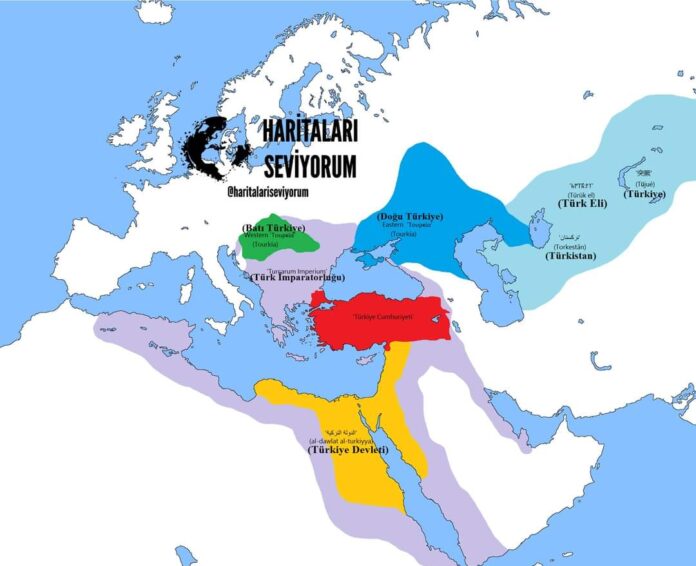Tourkia (Greek: Τουρκία) may refer to:
- Turkey, a country in southeastern Europe and western Asia
- The name of Turkey in modern Greek
- The name of the Ottoman Empire in medieval and early modern Greek
- Tourkia (Khazaria) (“eastern Tourkia”), designation for the early medieval Khazar state in Byzantine sources
- Tourkia (Hungary) (“western Tourkia”), designation for the medieval Hungarian state in Byzantine sources
Principality of Hungary https://en.wikipedia.org/wiki/Principality_of_Hungary
In contemporary Byzantine sources, written in Greek, the country was known as “Western Tourkia”[26][27] in contrast to eastern or Khazar Tourkia. The Jewish Hasdai ibn Shaprut around 960 called the polity “the land of the Hungrin” (the land of the Hungarians) in a letter to Joseph of the Khazars.[28] Constantine VII’s De Administrando Imperio, written around 950 AD, tries to define precisely the whole land of the Hungarians, or Tourkia.[39] Constantine described the previous inhabitants of Hungary (e.g., the Moravians), described early Hungarian settlements and neighbors, and located Hungarian rivers (Temes, Maros, Körös, Tisza, Tutisz).[39]
Constantine had much more knowledge about the eastern parts of Hungary; therefore, according to one theory, Tourkia did not mean the land of the whole federation, but a tribal settlement, and the source of the description of Hungary could have been Gyula whose tribe populated the five rivers around 950.[39]
According to another hypothesis, mainly based on Constantine’s description, the Hungarians started to really settle western Hungary (Transdanubia) only after 950, because the eastern part of the country was more suitable for a nomadic lifestyle.[39]
Christianization Main article: History of Christianity in Hungary
See also: Metropolitanate of Tourkia https://en.wikipedia.org/wiki/Metropolitanate_of_Tourkia
Organization of the state Until 907 (or 904), the Hungarian state was under joint rule (perhaps adopted from the Khazars). The kingship had been divided between the sacral king (some sources report the titles “prince”[50] or “khan”[51]), or Kende, and the military leader, or gyula. It is not known which of the two roles were assigned to Árpád and which to Kurszán.[citation needed] Possibly, after the Kende Kurszán’s death, this division ceased and Árpád became the sole ruler of the principality.
The Byzantine Constantine Porphyrogennetos called Árpád “ho megas Tourkias archon” (the great prince of Tourkia),[52] and all of the 10th-century princes who ruled the country held this title.[5] Peter B. Golden, Nomads and their neighbours in the Russian steppe: Turks, Khazars and Qipchaqs, Ashgate/Variorum, 2003. “Tenth-century Byzantine sources, speaking in cultural more than ethnic terms, acknowledged a wide zone of diffusion by referring to the Khazar lands as ‘Eastern Tourkia’ and Hungary as ‘Western Tourkia.'” Carter Vaughn Findley, The Turks in the World History Archived 5 February 2016 at the Wayback Machine, Oxford University Press, 2005, p. 51, citing Peter B. Golden, ‘Imperial Ideology and the Sources of Political Unity Amongst the Pre-Činggisid Nomads of Western Eurasia,’ Archivum Eurasiae Medii Aevi 2 (1982), 37–76.
Bati Türkiye / Western Turkey ; The Principality of Hungary, also referred as Western Tourkia. https://en.m.wikipedia.org/wiki/Principality_of_Hungary
Doğu Türkiye – Eastern Turkey; Khazar Khanate, also rederred as Eastern Tourkia. https://en.m.wikipedia.org/wiki/Khazars
Dawlat Al Turkiyya ; Mamluks, also known as the State of the Turks. https://en.m.wikipedia.org/wiki/Mamluk_Sultanate_(Cairo)





















